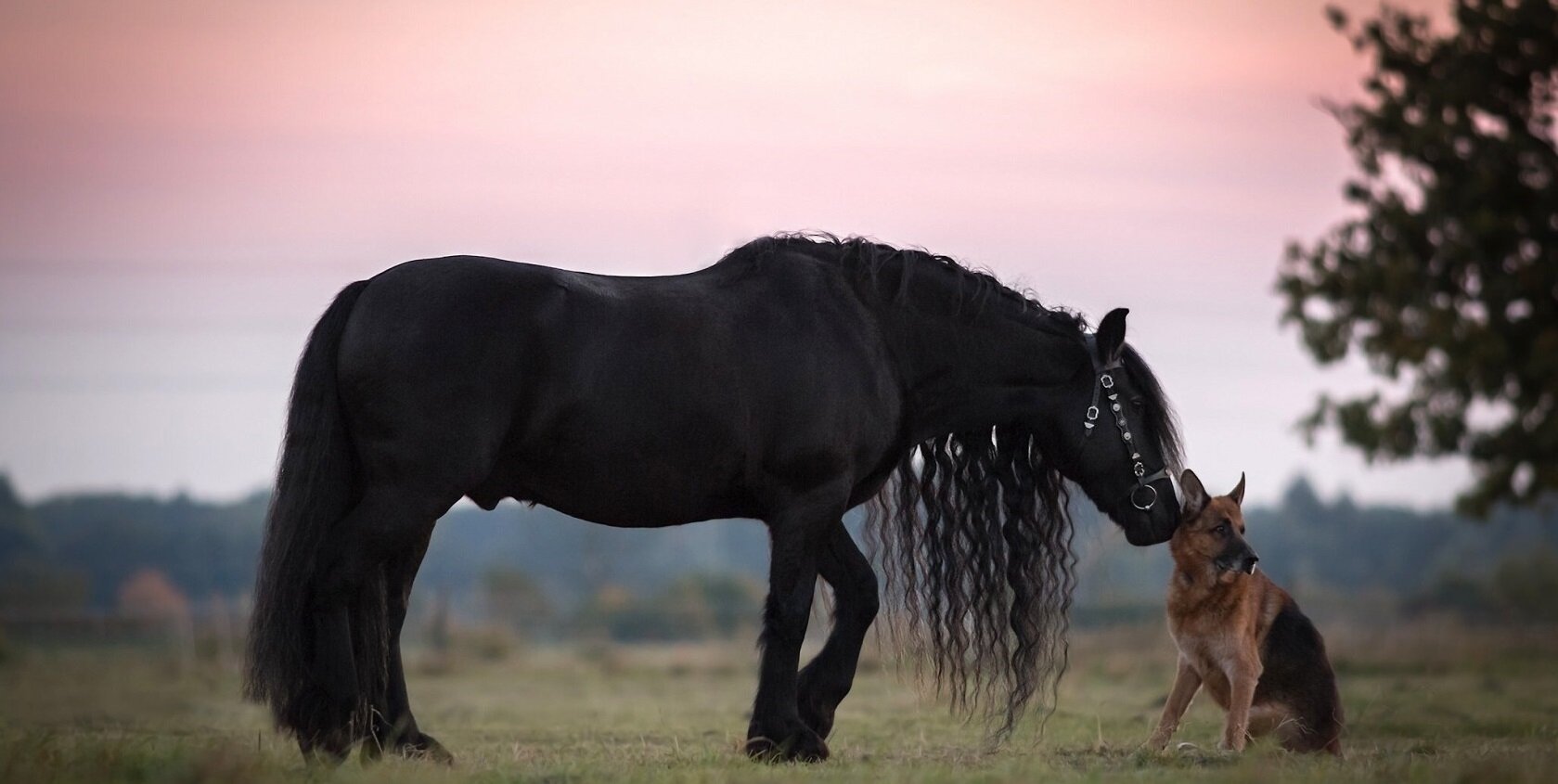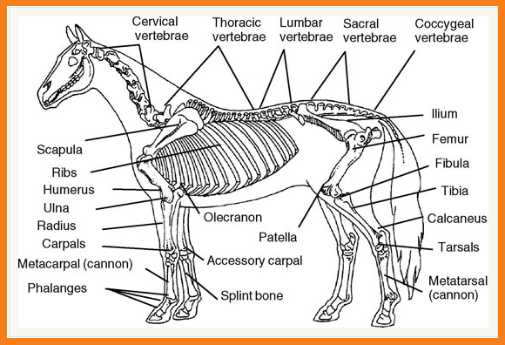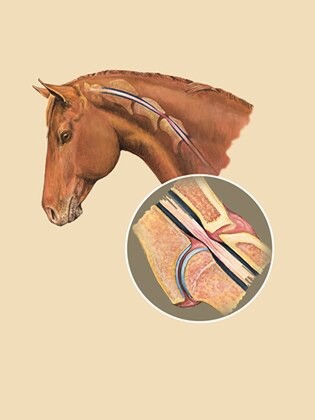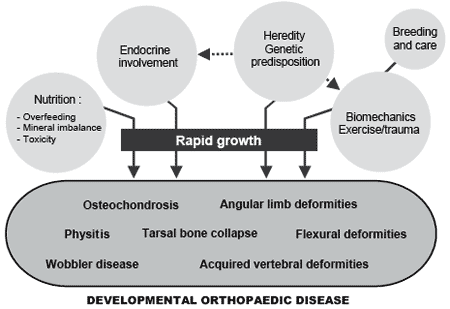I have recently been dealing with thoroughbreds and standardbreds that have got certain problems due skeletal formation of the equine. Thus, this blog is mostly for having an understanding of horse's skeletal development and primary causes of DOD and Wobbler's syndrome which appears to be directly related to growth spurts and nutrition.
There also appears to be some genetic predisposition to DOD's. As a previous manager we had to quickly learn the direct link to nutrition with DOD's and to take great care with nutrition and manual therapy to help with their development.
Dr Deb Bennett PhD of the University of Kansas, and is internationally known for her scientific conformation analysis. In her thought provoking article called “About Maturity and Growth Plates,” she gives a detailed analysis of the skeletal formation and maturity of the equine.According to Deb, there is a definitive schedule for bone formation, and this schedule is what needs to be followed, not the appearance of the horse.
The order of fusion and development of the equine skeletal structure begins from the bottom up. This, of course, results in the spine being the last to develop and fully fuse.“The spine does not fuse until the horse is at least 5-1/2 years old. This figure applies to all horses, small range horses to huge Warmbloods.
The taller your horse and the longer its neck, the later full fusion occurs. For a male add six months. So, for example, a 17-hand TB or WB gelding may not be fully mature until his 8th year. Something that owners of such individuals do not realise the implications.
Deb noted that the vertebrae at the base of the neck are the very last to fuse, and she states that it is imperative to not yank on a horse’s head during this developmental stage.Developmental orthopaedic disease (or DOD for short) is the name given to a group of bone growth disorders that commonly occur in young horses.
The DOD group of disorders all result from defects in normal bone formation as young horses grow and develop. The breeds most commonly affected are those that are large, fast-growing, light horse breeds, particularly the standardbred and the thoroughbred. DOD lesions are very common and cause a significant economic loss to the horse industry.
Lesions are reported to be present in 20-25% of Thoroughbreds, with a quarter of these occurring in the vertebrae in the neck and the remainder in the leg bones.
An "Equine Wobbler" is a horse with a damaged spinal cord. Swelling and developmental changes in the vertebrae of the neck can lead to narrowing of the vertebral canal and compression of the spinal cord. This in turn can cause the typical symptoms of wobbler syndrome where the horse becomes inco-ordinated, particularly in the hind limb. Wobbler syndrome can be caused by anything that damages the spinal cord in the neck region but developmental bone disorders are the most frequent cause in horses less than 4 years old.
Your horse may be a wobbler if you are seeing one or more of the following signs: horse stumbling or stumbles more often under saddle. Any abnormal wear of front toes. Unusual sores on front heels from over-reaching, excessive movement of tail when trotting. Bunny hop when cantering; excessive knuckling of hind legs when stopping; When going uphill, is there any outward rotation of hind toes;The most obvious clinical sign is an abnormal gait characterized by wobbling, or a horse that looks like he's had a fair amount of tranquilizers. Mild cases may only present an inability to change leads, stop smoothly, or a negative change in behavior that results in poor performance. The mild cases are often confused with subtle problems of the hind legs, especially of the hock and stifle. The hind limbs are affected because the nerves which supply the area are located on the outside of the spinal cord in the cervical (neck) area and therefore are more easily damaged than nerves leading to the front limbs which are protected deep within the spinal cord. A horse flipping over backwards, Severe damage can actually result in a horse that may fall and have difficulty getting up.CAUSES OF DOD The cause of DOD has not been fully determined but appears to be multifactorial, with the major factors being rapid growth rates, trauma or stress on the growth plates or joint cartilage, a genetic predisposition and nutritional imbalances. The presence of two or more of these factors significantly increases the risk of DOD.Growth RateRapid growth seems to be one of the major factors in the development of DOD. The larger the body size and the faster the growth rate the greater the risk of DOD developing. The high-risk period for the development of bone and joint related abnormalities appears to be from 3 to 9 months of age. This correlates with the peak of lactation in the mare, through weaning to yearling age. During this time growth rates can easily be boosted above average by a combination of overfeeding and inadequate exercise.Depending on the exact cause of the Wobblers Syndrome, treatment can include surgery, drug therapy and changes in the horse's management. Drugs can help reduce swelling that might be impairing the spinal column. Surgery can be done to support the damage vertebrae. Nutritional therapy, Manual therapy, exercise can all contribute to recovery from Wobblers Syndrome.
By creating a natural boarding environment for your horse, your horse can develop a strong and sound body and subsequent carrying shape. By living in a simple, natural boarding situation, your horse will flex to each side and move through the natural gaits regularly as they travel through the paddock together. Their bodies and feet will change dramatically for the better, and will lessen the frequency your trimmer, saving you money and saving potentially sick horses from living unnaturally.Through simple acts of using slow feeders, hay nets and other stimulating things with a track paddock, your horses will get regular exercise and enjoyment in living an active life with their families.
Thus, a sound understanding of the equine body skeletal formation and management with correct trimming/shoeing, nutrition, manual therapy, dental, veterinary all play a major role for longevity of health in the early stages of an equine’s life.



